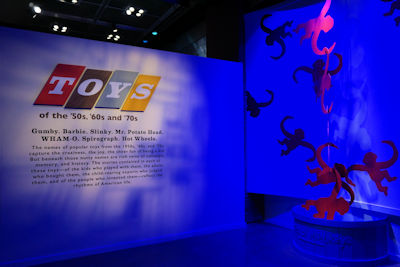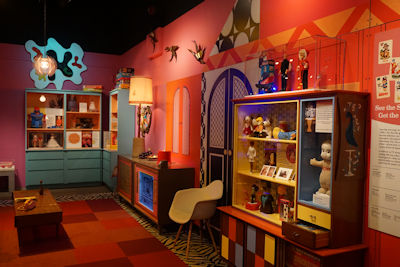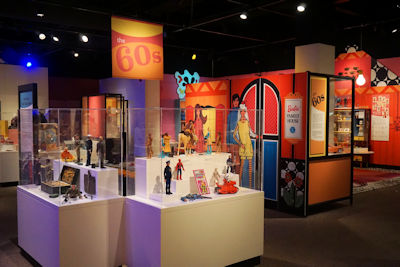
In Toy Story, the groundbreaking computer-animated film from 1995, the toys of our youth magically come to life when left unattended. They can walk on their own, converse with each other, and even build friendships. We first witness this transformation in the bedroom of a boy named Andy Davis that contains his all of his favorite playthings.
And what a collection it is! From Mr. Potato Head to a Slinky Dog, plastic green army men to a Barrel of Monkeys, a pull-string cowboy to a space ranger action figure, young Andy indeed has it all. Although geared towards kids, Toy Story was a hit with children of all ages, fostering a thrill of nostalgia in adults as well as a sense of adventure for their offspring.
The Senator John Heinz History Center brought that nostalgia and sense of adventure to Pittsburgh in March 2016 courtesy of a traveling exhibit created by the Minnesota Historical Society entitled Toys of the ’50s, ’60s and ’70s. There may not have been a Woody the Cowboy or Buzz Lightyear on display – and none of the toys were able to walk and talk of their own volition – but childhoods from bygone years were brought back to life nonetheless with a collection that included Barbie, G.I. Joe, Rock ‘Em Sock ‘Em Robots and Matchbox cars.
“The names of popular toys from the 1950s, ’60s and ’70s capture the craziness, the joy, the sheer fun of being a kid,” Toys of the ’50s, ’60s and ’70s exclaimed at its entrance. “But beneath those nutty names are rich veins of nostalgia, memory and history. The stories contained in each of these toys – of the kids who played with them, the adults who bought them, the child-rearing experts who judged them and the people who invented them – reflect the rhythms of American life.”
Although the concept of toys dates back to prehistoric times – dolls of various types and sizes have been found in archaeological sites around the world – it was during the post-World War II era that they began to flourish in abundance. The United States witnessed an economic boom in the 1950s as birth rates soared and more and more Americans were purchasing homes and raising families. Realizing the increase in the number of children that needed to be kept happy – and the larger paychecks in consumer bank accounts – manufacturers across the globe began churning out a wide range of new products from traditional dolls to family-themed board games.
Even construction toys that originated in the early 1900s witnessed a resurgence in the 1950s as updated versions of Lincoln Logs, Tinkertoys and Erector sets once again became popular. Unlike prior incarnations, these new building blocks were made from plastic, which proved to be more durable and easier to put together. In fact, a carpenter in Denmark named Ole Kirk Christiansen initially crafted his trademarked LEGO toys out of wood before switching to plastic in 1947, a decision that his son Godtfred then developed into the still-popular modern “brick” design of today.
Arguably the greatest area for inspiration was the media. Pop Culture icons like Dick Tracy, Hopalong Cassidy, Howdy Doody and the Lone Ranger may have begun life in newspaper comic strips and on television sets but their popularity grew larger as puppets and action figures based on their images made their way from local department stores into homes and houses. The living room, meanwhile, transformed into modernized play rooms with brand new TVs and toys that derived directly from the small screen.
While television would both remain and grow as a major source for new products, toy designers also looked to other areas for their creations. The Space Age, for instance, spawned countless products based on the real-life explorations of NASA as well as science fiction-themed space robots and flying saucers. Drag racing, meanwhile, became the inspiration for Hot Wheels, which were more sleek and flashier that the traditional realism of rival Matchbox.
While the American-based Mattel usurped the small design concept of London’s Matchbox for Hot Wheels in 1967, the company’s greatest success was likewise a redesign of a European product – the Barbie doll. Five years after Barbie’s premier, rival Hasbro attempted to duplicate that success with a male version dubbed G.I. Joe. Believing that boys would never buy a “doll,” Hasbro vice president Don Levine insisted that the new toy be called an “action figure” instead.
Two million G.I. Joe’s were sold in 1964, paving the way for additional action figures based on everything from DC and Marvel comic book superheroes to cowboys and Action Jacksons. The popularity of the action figure increased dramatically in 1977 with the release of Star Wars. Thanks to the epic saga of George Lucas, action figures suddenly became more than just toys but collectibles craved by adults who proudly displayed them in their homes.
The above represents just a small fraction of the items on display within Toys of the ’50s, ’60s and ’70s. The exhibit was designed as a series of living rooms from each decade that showcased the changing nature of American life through the years, while everything from Charlie Brown to Frankenstein’s monster lined the shelves. A re-created back yard, meanwhile, was filled with a bicycle, Big Wheel, Nerf balls and giant dollhouse.
Display cases were likewise scattered in the walkways, shining the spotlight on such icons as Mr. Potato Head, Tonka trucks and action figures of every variety. It didn’t matter when you were born, or what you favorite play item was as a child, the Toys of the ’50s, ’60s and ’70s exhibit was a literal walk down memory lane for everyone who attended.
“I’m not a space ranger,” a distraught Buzz Lightyear laments in Toy Story. “I’m just a toy. A stupid, little, insignificant toy.” But the pull-string Woody the Cowboy has a different opinion than his more modern and futuristic counterpart. “Being a toy is a lot better than being a space ranger,” Woody tells Buzz. “Over in that house is a kid who thinks you are the greatest. And it’s not because you’re a space ranger, pal, it’s because you’re a toy. You are his toy.”
We’ve all had a special toy that was “ours,” a toy that no doubt helped shape the person we later became as an adult. For a short matter of months at the Heinz History Center in Pittsburgh – as well as the numerous other cities around the country that the exhibit traveled – Toys of the ’50s, ’60s and ’70s allowed visitors to not only remember that special toy but the wide-eyed adventure known as childhood as well.
Anthony Letizia





